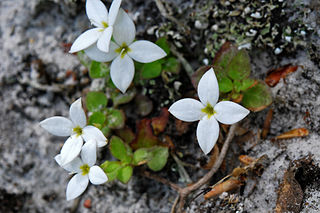Harold Ernest Robinson was an American botanist and entomologist.

Houstonia caerulea, commonly known as azure bluet, Quaker ladies, or bluets, is a perennial species in the family Rubiaceae. It is native to eastern Canada and the eastern United States. It is found in a variety of habitats such as cliffs, alpine zones, forests, meadows and shores of rivers or lakes.

Oldenlandiopsis (creeping-bluet) is a genus of flowering plants in the family Rubiaceae. It is monospecific, comprising only one species, Oldenlandiopsis callitrichoides. This species had previously been placed in Hedyotis or in Oldenlandia. It is native to the West Indies, southern Mexico, and Central America. It is naturalized elsewhere, including Florida, Hawaii, South America, and tropical Africa.

Houstonia (bluet) is a genus of plants in the family Rubiaceae. Many species were formerly classified, along with other genera since segregated elsewhere, in a more inclusive genus Hedyotis.

Houstonia longifolia, commonly known as long-leaved bluet or longleaf summer bluet, is a perennial plant in the family Rubiaceae. It can be found throughout most of the Eastern United States and Canada. It has been reported from every state east of the Mississippi River except Delaware, plus North Dakota, Minnesota, Missouri, Arkansas and Oklahoma, with isolated populations in Kansas and Texas. Also, all Canadian provinces from Quebec to Alberta. It prefers upland woods in poor, dry, often sandy soil.

Alexander Watkins Terrell was an American lawyer, judge, planter, Confederate officer, and diplomat. He served as the U. S. Envoy to the Ottoman Empire and a Confederate military officer. He helped pass influential legislation including the Terrell Election Law, served as president of the Texas State Historical Association and on the board of regents for the University of Texas.

Kadua is a genus of flowering plants in the family Rubiaceae. It comprises 29 species, all restricted to Polynesia. Twenty-two of these are endemic to the Hawaiian Islands. Some of the species are common at high elevation. Others are single-island endemics or very rare, and a few are probably extinct. Kadua affinis is widely distributed in Hawaii and is polymorphic. The type species for the genus is Kadua acuminata.

Arcytophyllum is a genus of flowering plants in the family Rubiaceae. The genus contains 18 species, distributed from New Mexico to Bolivia.

Houstonia procumbens, the roundleaf bluet, is a perennial species in the family Rubiaceae. It is native to the southeastern United States: Louisiana, Mississippi, Alabama, Georgia, Florida and South Carolina. Its native habitats include disturbed sites, and moist, open, sandy areas. Flowers bloom March to October.
Houstonia ouachitana, the Ouachita bluet, is a species of plants in the coffee family. It is endemic to the Ouachita Mountains of Arkansas and Oklahoma. It is an herb up to 20 cm tall, with lanceloate basal leaves and narrowly linear cauline leaves.

Houstonia correllii, the Zapata County bluet, or Correll's bluet, is a species of plants in the Rubiaceae. It is known only from Zapata County in southern Texas. It is a prostrate, mat-forming plant with white flowers.
Houstonia acerosa, the New Mexico bluet or needleleaf bluet, is a plant species native to Chihuahua, Coahuila, Nuevo León, Tamaulipas, San Luis Potosí, Texas and New Mexico.
Houstonia palmeri, the Saltillo bluet, is a plant species in the family Rubiaceae, native to the Mexican states of Coahuila and Nuevo León.
Houstonia teretifolia is a plant species in the family Rubiaceae, endemic to the Mexican state of Coahuila.
Houstonia canadensis, common name Canadian summer bluet, is a plant species native to the United States and Canada. It has been reported from Ontario, Saskatchewan, New York, Pennsylvania, Ohio, Indiana, Illinois, Michigan, Kentucky, Missouri, Tennessee, West Virginia, western Virginia, and mountainous regions of western North Carolina, western South Carolina, and northern Georgia.

Houstonia micrantha, the southern bluet, is a plant species in the coffee family.
Houstonia spellenbergii is a plant species in the family Rubiaceae. It is native to the western part of the state of Chihuahua in northern Mexico, at an elevation of approximately 2100 m in the Sierra Madre Occidental near the Basaseáchic waterfall.

Spermacoceae is a tribe of flowering plants in the family Rubiaceae and contains about 1346 species in 57 genera. Its representatives are found in the tropics and subtropics.
Balsamorhiza rosea is a North American species of plants in the sunflower tribe within the aster family. It is native to the northwestern United States, in Washington and Oregon.









